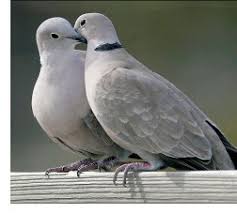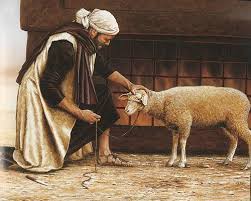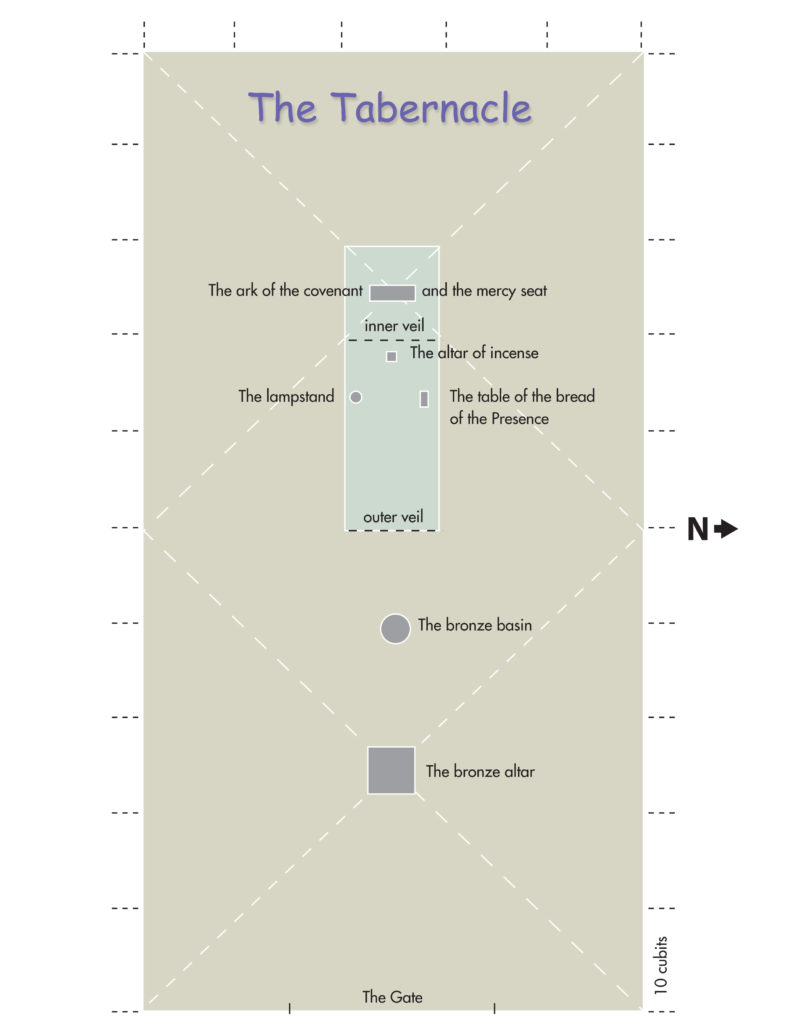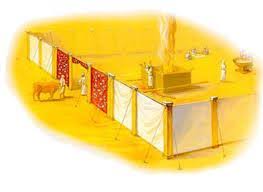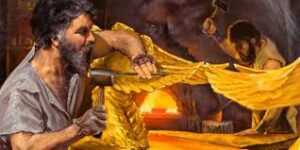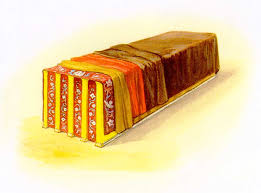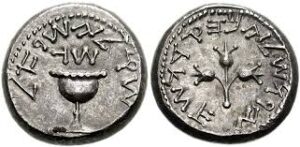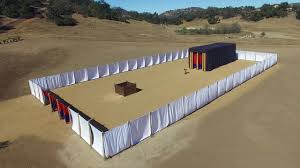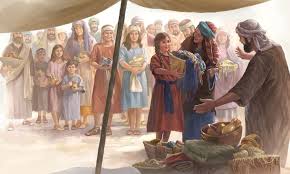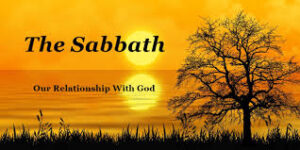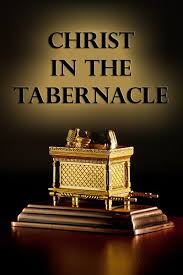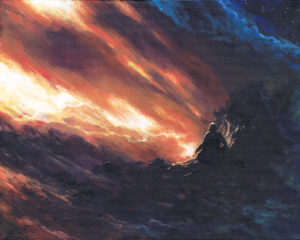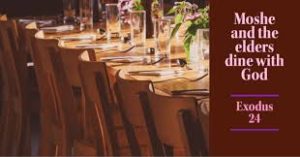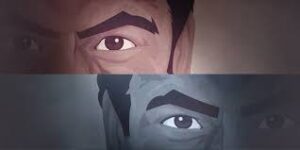Fd – The Guilt Offering Leviticus 5:14 to 6:7 and 7:1-6
The Guilt Offering
Leviticus 5:14 to 6:7 and 7:1-6
The guilt offering DIG: How was the guilt offering different from the sin offering? For what kind of sin is restitution possible (5:16 and 6:1-5)? Which require a twenty percent fine? What does this teach you about God’s view of sin? What does this teach you about ADONAI’s view of the process of reconciliation? What is His desire for His followers?
REFLECT: If you were to assign a money value to your sins, what would they be worth? How far in debt would you be: (a) One week’s allowance? (b) One month’s wages? (c) Half this country’s foreign debt? (d) More than the national deficit? How can such debt be cancelled: By you? Your creditors? By God? When in your experience has YHVH cancelled your debt of guilt? What did it cost (see Matthew 18:21-25)?
The guilt offering was a mandatory atonement for an intentional or unintentional violation requiring restitution, the confession of a sin, and forgiveness of a sin or cleansing from defilement. It required not only a ram, but also a twenty percent fine to the wronged party. The difference between this and the sin offering was that the guilt offering was compulsory, in cases were restitution was necessary.
It was not easy to distinguish between the sin offering and the guilt offering for both represented Christ, the Substitute for the guilty sinner. Because it was not totally consumed, the bodies of the offerings were burned outside the camp of Isra’el. Both were to atone for sins committed knowingly or through ignorance. Yet, the sin offering dealt with the root of sin, even as the guilt offering dealt with the fruit of sin. While believers have been saved, for all time, by faith in the shed blood of the great Sin Offering, we still inherit our old sin nature. That is what Paul meant when, in the sixth and seventh chapters of Romans, he wrote of the struggle between the old nature and the new nature in Christ, the flesh and the spirit, the nature inherited from Adam and the new life received by faith in Jesus Christ. When Paul wrote those chapters, he put words to the struggle that all believers know far to well – what he wants to do because he loved Jesus, he does not do; and what he does not want to do, he finds himself doing because of the weakness and frailty of his flesh (Romans 7:24). But then the great chapter eight of Romans follows, which gives the secret to victory over the flesh – the indwelling Holy Spirit. Thus, every need of the sinner is fully met in Jesus Christ. He is our Guilt Offering, giving us power and victory in our lives, even as He promised. If we confess our sins, He is faithful and just to forgive us our sins and purify us from all unrighteousness (First John 1:8-10).538
In Hebrew, the guilt offering comes from the word asham, meaning guilt. Restitution was necessary, and the Hebrew word for trespass comes from the word ma’al, meaning a violation of another person, either God or man, of what was rightfully his. The sin offering emphasized the sin itself, whereas the guilt offering emphasized the practice and harmful effects of the sin. This offering required confession and restitution for wrongdoing. The Holy Spirit deals with this offering in two ways. First in 5:14-19, violations against God’s holy things are dealt with, and then in 6:1-7, violations against man are dealt with. Lastly, the function of the priest in the guilt offering is dealt with in Leviticus 7:1-6.
Explicitly, the guilt offering is never mentioned in the New Covenant. But it is mentioned implicitly, because Isaiah 53:10 says that Christ is the guilt offering. Therefore, using that as our context, Isaiah 53:1 is quoted in John 12:38 and Romans 10:16. Isaiah 53:4 is quoted by Matthew 8:12, Isaiah 53:5-6 is quoted by First Peter 2:24-25. Isaiah 53:9 is quoted by First Peter 2:25 and Isaiah 53:12 is quoted by Luke 22:37. So there is an indirect mention of the Guilt Offering in the New Covenant in the death of Christ.

First, there were violations against God’s holy things. When a person committed a violation and sinned unintentionally in regard to any of ADONAI’s holy things, or sacred property, such as gifts (Deuteronomy 15:19), sacrifices, tithes, first fruits (Exodus 34:26), or anything assigned to God. It had to do with a violation of that which belonged to God, and therefore indirectly, the priesthood since they were his representatives. It could include, for example, failure to redeem the first-born. In that case, the guilty would bring a ram from his flock as a penalty to ADONAI, one without defect. So the value of the property had to be estimated. But if he could not bring the ram itself, he could bring the equivalent value in silver, according to the sanctuary shekel (30:11-16). The rabbis teach that because the word is plural, the value had to be a minimum of two shekels. A ram was more valuable than either a lamb or a female goat, therefore, it showed that the guilt offering was a more serious offense than the sin offering. The sin offering emphasized our sin nature, but the guilt offering emphasized active sin or choices that were made. Because he needed to make restitution for what he had failed to do in regard to the holy things, He then added a fifth of the value (or twenty percent) to the original cost. Since the sin in this case was against God, the restitution was made to His representative, the priest, who made atonement for him with the ram as a guilt offering, and then he was forgiven (Leviticus 5:14-16).
When the priest received the ram he slaughtered it on the north side of the bronze altar, and its blood was sprinkled on all sides. All its fat was offered; the fat tail and the fat that covered the inner parts, both kidneys with the fat on them near the loins, and the covering of the liver, which was to be removed with the kidneys. The priest then burned them on the bronze altar as an offering made to ADONAI by fire. It was a guilt offering. Any male in a priest’s family was allowed to eat it, but it had to be eaten in the courtyard of the Tabernacle because it was most holy (Leviticus 7:1-6).
There is no contradiction between twenty percent restitution here and the hundred percent restitution in Exodus 22:4-14. There, the offender did not confess his sin, but was convicted because of the evidence and therefore had to pay one hundred percent restitution. But here, the offender confessed voluntarily, which limited his restitution to twenty percent. There was, and is, a big difference between conviction and confession.
If a person sinned and did what was forbidden in any of ADONAI’s commands, even though he did not know it, he was still guilty and would be held responsible. There was no excuse, even if he didn’t realize it. He was to bring a ram from the flock to the priest as a guilt offering, one without defect and of the proper value. In that way, the priest would make atonement for him for the wrong he had committed unintentionally, and he would then be forgiven. In this case there is no restitution mentioned, because this was a sin against God alone, whereas, the previous one was against God and the priesthood who depended on the holy things. So sin against God required forgiveness but not restitution, but sin against man required forgiveness and restitution (Lev 5:17-19).
Secondly, there were violations against man in relationship to money or property rights. If anyone sinned and was unfaithful to ADONAI by deceiving his neighbor about something entrusted to him or left in his care, something stolen, if he cheated him, if he found lost property and lied about it, if he swore falsely, or if he committed any such sin that people may do – he thus was guilty. He returned what he had stolen or taken by extortion, what was entrusted to him, the lost property he found, or whatever it was he swore falsely about. He made restitution in full, and added a fifth of the value (or a twenty percent fine) to it. Since the violation was against human property rights, the restitution payment and fine were given to the owner on the day he presented his guilt offering. But if the offended party was no longer living and had no surviving relative, the restitution and fine were paid to the priest (Numbers 5:8-10).539 In that way, the priest made atonement for him before ADONAI, and he was forgiven for any of the things he did that made him guilty (Leviticus 6:1-7). Therefore, once restitution had been paid, God was satisfied and fellowship could be restored not only between the victim and the guilty party, but also between God and the guilty party.
There were other violations that also required the guilt offering. First, there was the cleansing of a leper (Leviticus 14:10-14); secondly, anyone having sex with an engaged female slave (Leviticus 19:20-22); and thirdly, the cleansing of a defiled Nazirite (Numbers 6:9-12). When we violate the Torah’s true meaning, which the Messiah upholds (Galatians 6:2 CJB), what is our penalty today?
The wages of sin is death (Romans 6:23a). The wages of work is money, but the wages of sin is death. In other words, what I earn – the penalty, the punishment of sin – is death. Death is separation. The Scriptures speak of two kinds of death, or two kinds of separation. The first death is separation of the body and the soul. If I were to die right now my body would fall to the floor, but my soul, the real me, would go somewhere else. But the Bible speaks of another death, or the second death. This second death is separation of the soul from God. Now, the penalty of sin is death, spiritual death, and separation from God. To put it simply – hell. All this is really bad news. But there is good news.540



